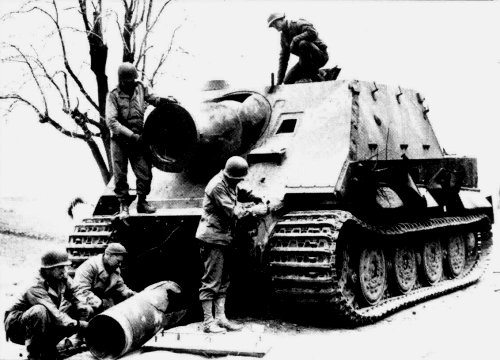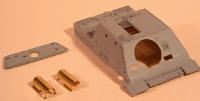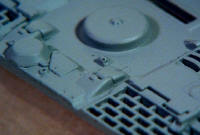
|
KIT: |
Dragon Sturmtiger 38cm Assault Mortar |
|
KIT # |
7204 |
|
PRICE: |
@$10.00 |
|
DECALS: |
one option |
|
REVIEWER: |
Chris Crofoot |
|
NOTES: |
Cast metal upper hull |

|
HISTORY |
 This more
powerful assault mortar took shape in the mating of a naval weapon, a
depth charge mortar, and the panzer VI chassis. Thus, was the Sturmtiger
or alternately the SturmMorser was born. The Sturmtigers were built on
Tiger I ausf.E chassis that had been returned from the fronts to the
factory for rebuilding. In the same vein as the Brummbar, they were
essentially the same vehicle with an armored box mounting a 38cm mortar
onto the Tiger chassis. The first Sturmtiger rolled out for Hitler’s
inspection on October 20, 1943.
This more
powerful assault mortar took shape in the mating of a naval weapon, a
depth charge mortar, and the panzer VI chassis. Thus, was the Sturmtiger
or alternately the SturmMorser was born. The Sturmtigers were built on
Tiger I ausf.E chassis that had been returned from the fronts to the
factory for rebuilding. In the same vein as the Brummbar, they were
essentially the same vehicle with an armored box mounting a 38cm mortar
onto the Tiger chassis. The first Sturmtiger rolled out for Hitler’s
inspection on October 20, 1943.
The main weapon of the Sturmtiger, the 38cm mortar was an impressive weapon. Originally designed as a naval anti-submarine weapon, the mortar was capable of throwing its five foot long, 750 lb, rocket propelled projectile nearly 6 kilometers. The round could penetrate 8.5 feet of steel reinforced concrete. As destructive as the weapon was it was also cumbersome. It took nearly ten minutes to load and a maximum of only fourteen rounds could be carried on board. To relieve the stress of such incredibly heavy recoil, a unique design vented the combustion gases through a sleeve surrounding the barrel. The barrel also employed a heavy counterweight on the front of the barrel to balance it. This gives the Sturmtiger its distinctive snub-nosed appearance. Reloading the Sturmtiger required the entire crew and was accomplished by means of an externally mounted crane and two hatches on the roof of the fighting compartment.
In all, only eighteen Sturmtigers were ever produced. Initially, two vehicles were used in suppressing the Warsaw Ghetto uprising. This is the only time that the Sturmtiger ever fulfilled its intended role of an urban combat stronghold demolisher. They were also used during the Arden offensive in December of 1944 but due to their slow speed they made little account of themselves. One anecdote claimed that a Sturmtiger destroyed four Allied Shermans with a single shell during fighting in 1945. Because of their high fuel consumption, slow speed, and the fact that the war situation had changed for the Germans these fearsome were of little combat value. Many were abandoned and destroyed by their crews for lack of ammunition or fuel.
|
THE KIT |
 The
kit comes well packed and contains three separately bagged light gray
plastic sprues, separately bagged metal hull, decals, and tracks. Of
immediate interest is the quality of casting on the upper metal hull. It
is excellent although my example was marred by some heavy spray runs of
primer. It sho
The
kit comes well packed and contains three separately bagged light gray
plastic sprues, separately bagged metal hull, decals, and tracks. Of
immediate interest is the quality of casting on the upper metal hull. It
is excellent although my example was marred by some heavy spray runs of
primer. It sho uld
be a breeze to sand this down and fix this though. The quality of the
plastic molding is good although I think Revell AG still has a definite
advantage in this scale. The rubber tracks are quite flexible and feel
like they’ll take a coat of paint very well. They are very well molded
and I don’t think that individual links will offer much over them. I
would recommend using thread to tie them down between the road wheels to
replicate the track sag of the prototype. The box examples show them
incorrectly
uld
be a breeze to sand this down and fix this though. The quality of the
plastic molding is good although I think Revell AG still has a definite
advantage in this scale. The rubber tracks are quite flexible and feel
like they’ll take a coat of paint very well. They are very well molded
and I don’t think that individual links will offer much over them. I
would recommend using thread to tie them down between the road wheels to
replicate the track sag of the prototype. The box examples show them
incorrectly
 taut
across the return side of the wheels.
taut
across the return side of the wheels.
A nice touch is the addition of one of the 38cm rounds. It looks as though it would be possible to mount the round in the tube. There is no interior included, but who does in this scale? The one gripe I might have is the loading crane. Although adequate, this is in many ways going to be a focal point in detailing and it would have been nice to see a little more attention paid to this part. The instructions are exploded view assembly steps of the actual kit parts and are good enough for even a first-time modeler. The metal hull fits the plastic lower hull like a glove and if that’s any indication the rest of the kit should be a fun build since there are only 115 parts to the total kit.
|
COLORS & MARKINGS |
 Gunze
and Italeri color callouts are provided. There are some excellent color
illustrations of the finished kit to help the modeler. Decals for one
vehicle are provided since there wasn’t a great deal of personalization
done to the prototypes.
Gunze
and Italeri color callouts are provided. There are some excellent color
illustrations of the finished kit to help the modeler. Decals for one
vehicle are provided since there wasn’t a great deal of personalization
done to the prototypes.
|
CONCLUSIONS |
I know some people have complained about the metal hull, but I don’t think it will be that bad. There are really only two parts of this kit the might need to be ground off and those are the shovel and track tool on the left-hand side of the vehicle. I was really impressed by the casting quality of the metal parts but less so by the plastic parts. They are by no means bad but comparing them to the Revell AG Tiger showed them to be not quite as good. Not to mention the fact that there are plenty of Tiger detailing accessories on the market that fit this kit as well as any other. Overall this is, I think, a great value for less than $10.00. Taking into account the prices and quality, I think it’s obvious that 1/72nd is going to be giving it’s bigger scale brothers some stiff competition. All told I give this kit a 9 on 10… go get yourself one or two…
|
REFERENCES |
If you would like your product reviewed fairly and quickly by a site that has over 250,000 visitors a month, please contact me or see other details in the Note to Contributors.